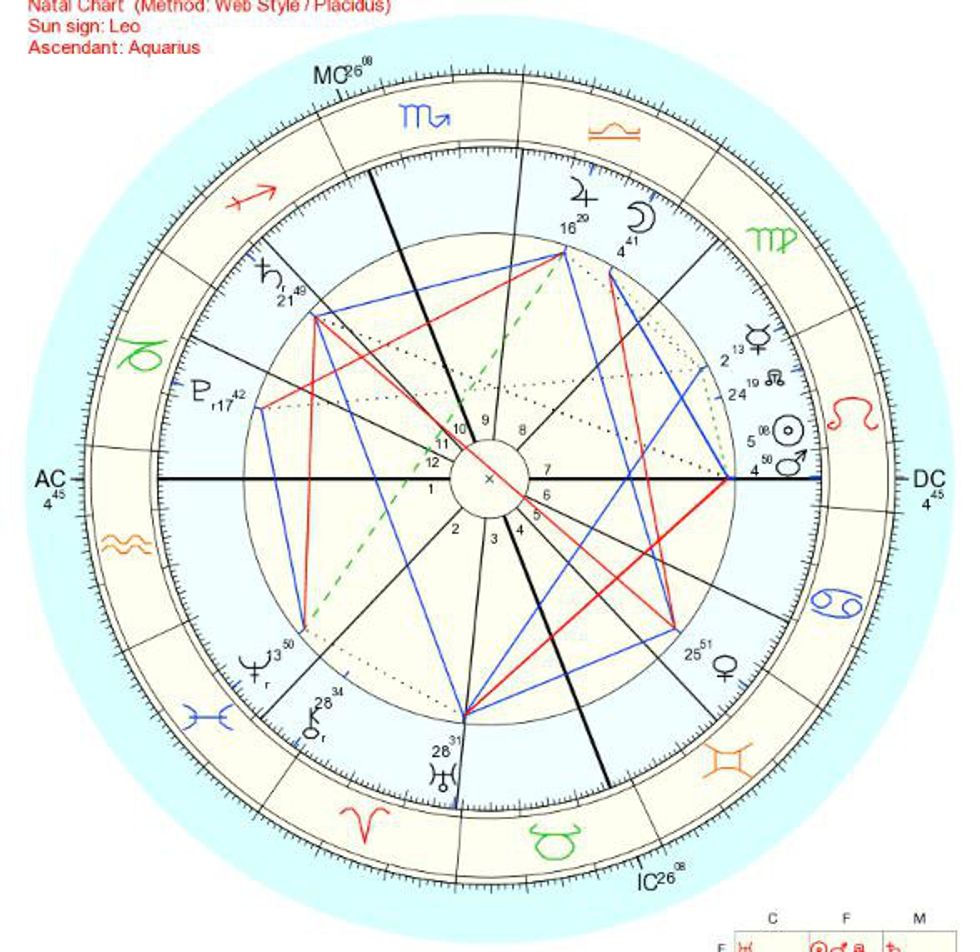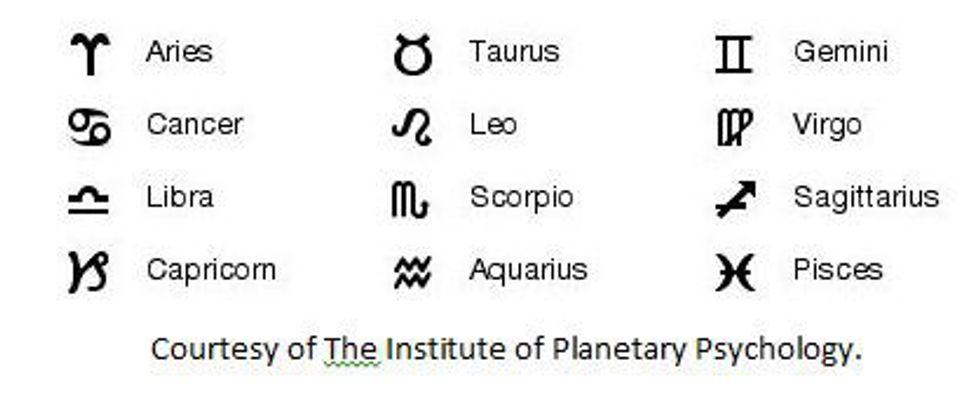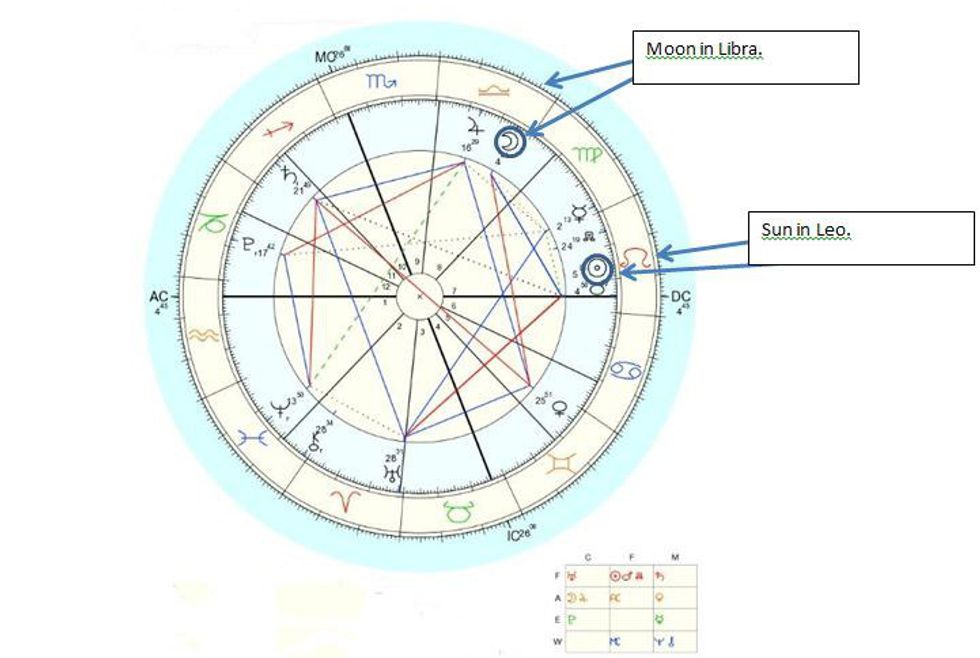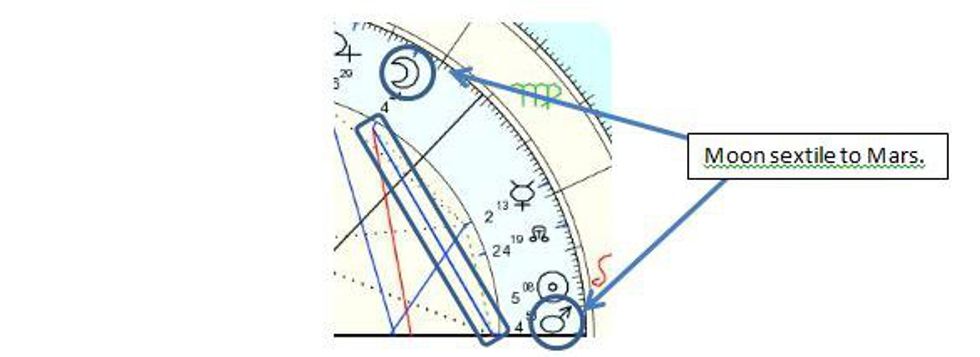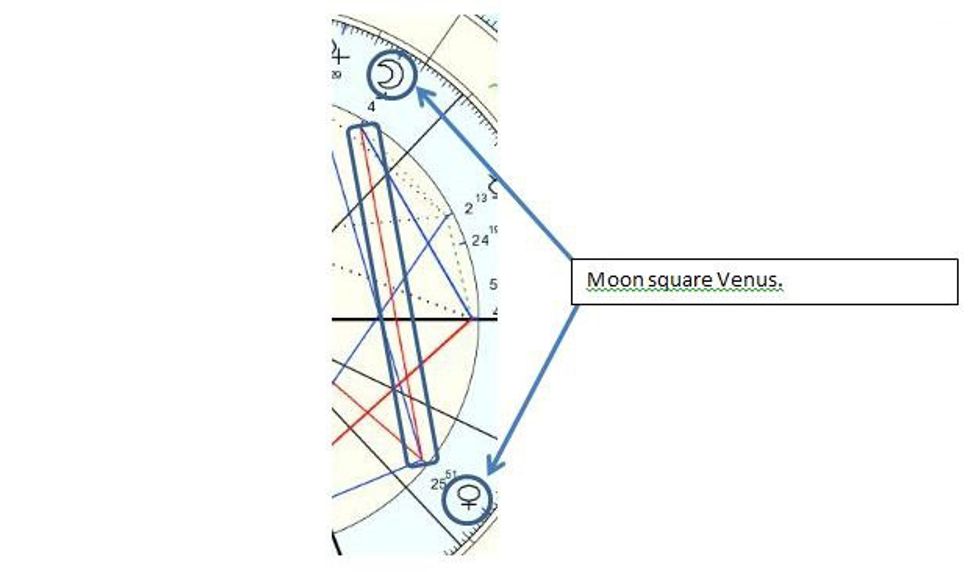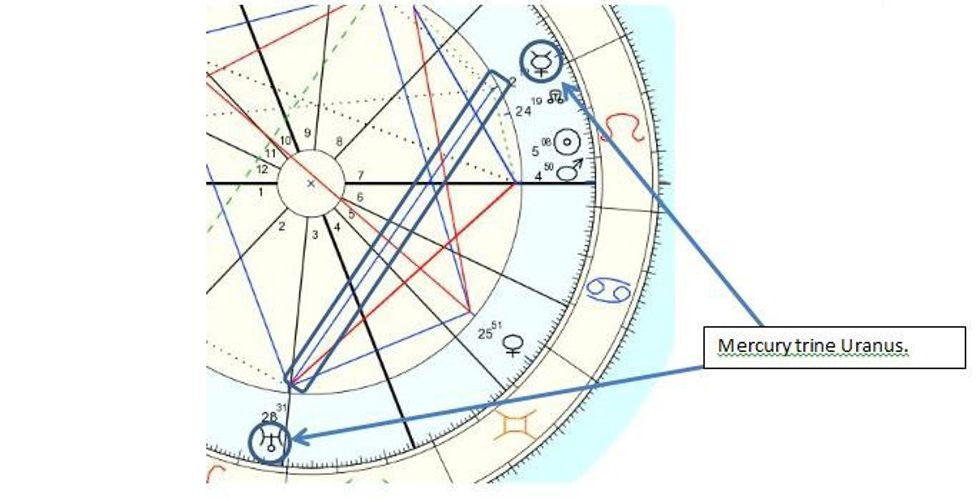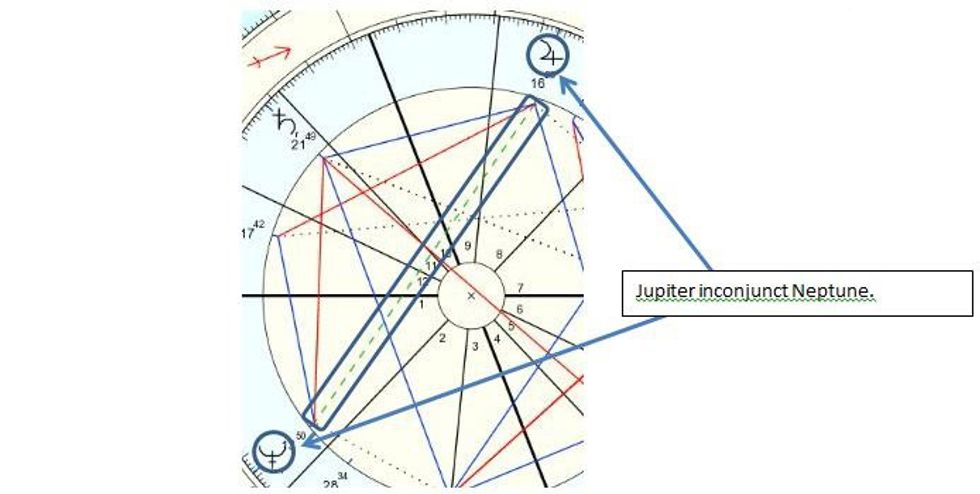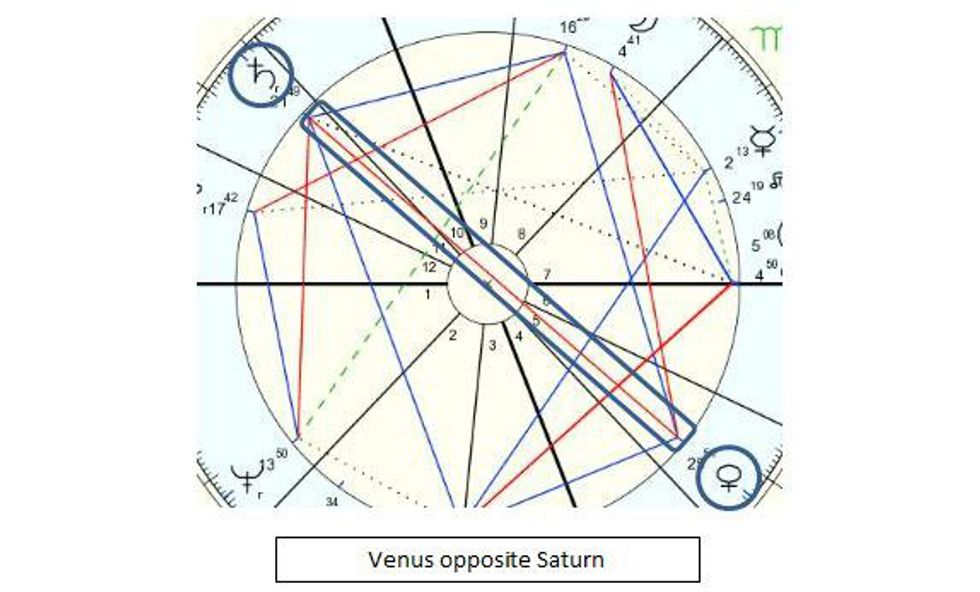You know, originally, I was only going to write an introductory article on the houses in astrology. However, a thought came to me before I could start it: “Darrah, you should explain how to read a birth chart before you dive straight into the houses.” So that’s what I’m going to do, now. This article is all about the birth chart and how to read it.
A birth chart (also called a natal chart) shows where the planets were located when you were born. In every birth chart, there are all twelve signs and all ten of the planets, and every birth chart is divided into twelve segments: the houses. Each sign encompasses thirty degrees (thirty degrees multiplied by twelve signs equals 360 degrees—a perfect circle). However, houses can vary in size depending on which chart method you use1. Placidus2 is my favorite method, so I’m going to use a Placidus chart in this article.
There are many places where you can draw up a free birth chart. I recommend astro.com, as its charts have proven to be the easiest to read. Placidus is the site’s default chart method.
You need the following in order to get a complete, accurate birth chart:
Your full date of birth.
Your place of birth (the closest major city can work, too).
Your time of birth. Try to get as close to the exact minute as you can. If you don’t know your time of birth, and your family members can’t quite remember, you can try to find it on your birth certificate. Just make sure to request it on the application. If your birth certificate doesn’t provide you with a time, it’s not the end of the world. You won’t know what your houses are, but you’ll still see the sign placements of your planets.
Here, we have a complete birth chart3. The signs are shown in the white outer part of the circle. Each sign’s glyph (symbol) is displayed in the color matching its element: red for fire; green for earth; yellow for air; blue for water. The planets are indicated by the glyphs on the inside of the chart (see glyphs below).
In the chart above, we see that this person has Sun in Leo and Moon in Libra. So we see this is the chart of a very sociable person, perhaps someone who is very involved in high culture and enjoys the finer things in life.
Also take note of the numbers which lie next to each planet’s symbol. That number (between 0 and 29) shows which degree of a sign a given planet was transiting during the time of the birth chart. The higher the number, the closer the planet is to going into the next sign. If you have a planet—especially the sun—at 28 or 29 degrees of a sign, that planet is said to be on the cusp of the current and next sign (i.e. Scorpio-Sagittarius cusp). Planets on the cusps of signs can be said to have the traits of both signs.
You may be curious as to how to find the houses in the birth chart. As shown above, the birth chart is divided into twelve sections, with each section having a number near the center of the chart. Each of those sections is a house. Each of the black dividing lines, called a cusp, indicates the starting point of a house, and helps the observer know which planet is in which house. The cusps for the First, Fourth, Seventh, and Tenth Houses are bolded lines, as they are extremely significant points; this is something that will be covered within the next several articles.
We see, in taking another look at our example chart, that the Leo Sun is in the Seventh House. Now, we know not only which traits (Leo; charismatic, creative, bold, proud, etc.) this person exhibits in his/her self-expression (Sun), but also the area of life in which that self-expression is most prominent. The Seventh House is the House of Others: the spouse, close friends, business partners, and other people with whom you tend to make one-on-one partnerships. With the Sun in the Seventh House, this person expresses themselves most (or best) when involved with a long-term partner, best friend, or business partner, or in anything that involves a two-person collaboration. The emphasis on partnership is further intensified by the Libra Moon, where the needs, emotions, and comforts (Moon) are directly tied in with partnerships (Libra). This could be a person who’s more apt to share the center of attention with another, or whose fame and marriage are very closely tied together. There will be much more detail on each house in later articles. I just wanted to let you test the waters now, right here, so you can get an idea of the temperature before diving into the next series.
The last things I want to point out here are the blue, red, and green-dashed lines inside the circle, connecting one planet to another. These lines are called aspects, and they’re extremely important. They show how planets interact with each other to give the chart holder specific mannerisms and characteristics, whether for better or for worse. The following are the six major aspects that are surveyed in astrology:
Conjunction: Of the major aspects, the conjunction is the easiest to see and memorize. A conjunction is when two planets are next to each other, usually within an orb4 of ten degrees. Conjunct planets are most often in the same sign, but it’s not uncommon to find one planet at the end of a sign, and the other planet in the beginning of the next one (i.e. Moon at 27 degrees Aries conjunct Mercury at 1 degree Taurus).
Sextile: A sextile is made when two planets are 60 degrees away from each other, within an orb of about six degrees. The planets involved are usually in signs of the same “gender” (masculine or feminine), but different elements and qualities.
Sextiles show a positive relationship between the planets involved, in which the chart ruler can gain their benefits if she puts a little effort into practicing them. So here, with the Moon sextile to Mars, the person can learn to assert his emotions and build confidence in expressing his needs—as long as he puts the work into it. This could also mean he can balance his aggressive or competitive side with his nurturing side.
Square: A square is a 90-degree angle made between two planets. It has an orb of five degrees. A traditional square consists of planets in signs of the same quality that are not opposing each other (i.e. Leo and Scorpio are both fixed signs, but are not opposite each other), but exceptions exist.
Squares are arguably the most challenging aspect. The planets involved in a square clash with each other; like boxers in a match. The Moon and Venus are square in our example chart, indicating clashes between the person’s needs, emotions, and ways of nurturing, and his sense of love and beauty, romantic nature, and charm. He is possibly prone to unfulfilling relationships, or he becomes a constant doormat or scapegoat. This doesn’t mean that all people with Moon squaring Venus will have these problems. They’re not set-in-stone traits, but tendencies which they can overcome if they learn to put the Moon and Venus at peace with each other. Moon square Venus is also commonly associated with distaste for women.
Trine: A trine forms when two planets are 120 degrees apart, within an orb of ten degrees. Planets in a trine are usually within signs of the same element, although it’s not always the case.
Trines are beneficial, just as sextiles are. The difference between trines and sextiles is that you have to work to get the benefits of sextiles, whereas trines are gifts. They show positive traits that a person naturally embodies without putting in the effort. So, here, we have Mercury trine Uranus. It’s highly possible that this person is a natural genius. (Mercury is intellect; Uranus, invention, originality, etc.). She is very good at coming up with fresh, new ideas, has a quirky sense of humor, and may outperform her peers. Of course, even good traits often come with bad consequences, such as getting teased for being a “nerd,” or feeling unfulfilled in the classroom because one’s schoolwork is too easy. Such negative consequences are the result of societal conditioning, rather than the fault of the individual.
Inconjunction (or Quincunx): Some consider the inconjunction a minor aspect; however, I think it’s important to note how it operates. The inconjunction is a 150-degree angle formed between two planets, and it usually forms between planets in signs that have nothing in common. It has an orb of only two degrees. Inconjunct signs—Capricorn and Gemini; Taurus and Sagittarius; Cancer and Aquarius, etc.—have different “genders,” elements, and qualities from each other.
Inconjunctions have been described as oppositions that never even out. Since the planets involved in an inconjunction are in immensely different signs, the planets fail to “get” each other. It’s not really a fight, such as the kind that happens in squares. It more closely resembles the awkwardness of being forced into conversation with someone totally different from yourself. Wouldn’t that feel strange?
Here, we have Jupiter inconjunct Neptune, a peculiar aspect. This could leave the person confused about his belief system or religious faith. Or his belief system could be out of touch with his compassion or imagination. Doctrine and spirituality fail to see eye-to-eye for him. In addition, Jupiter is faster than Neptune, and Jupiter moves through one sign per year. Because both planets are slow-moving, the aspect not only describes the chart holder, but also those born within, say, a few months of the chart holder. His friends would most likely have similar problems.
Opposition: the widest possible aspect in astrology is the opposition. It is 180 degrees (a straight line across the chart), and has an orb of ten degrees. As its name states, the opposition involves two planets that lie in opposite signs, although oppositions can sometimes occur between planets in inconjunct signs.
Opposite planets tug and pull at each other, trying to bring the other planet to its side. Remember—from the very first article, “Astrology Basics Part 1: The Signs”—that opposite signs have the same goal: they just have different views on those goals and try to achieve them in different ways. Leo is all about its own self-expression; Aquarius is about the expression of all people. Yet, both signs want to achieve expression. In oppositions, planets try to pull each other into their own ways of going about the same thing. However, each planet is so uncomfortable with the other way, it pulls itself back.
With Venus opposite Saturn, there is often a tug of war between love and responsibility. This person likely has a hard time balancing her career with her love life or social life. She may go back and forth between being sociable and being a loner. Finding a middle ground between work and leisure could prove difficult. She’ll have to do some tweaking to harmonize these two energies.
You’ve learned the information needed to obtain a birth chart. You’ve seen how a chart looks and how it’s structured. You’ve seen a little bit on how to piece planets, signs, and houses together. And you even learned the basics of aspects. You’ve learned a lot, today. And you’ll be able to learn even more, soon—about the Houses, that is.
Next Article (for sure, this time): “Astrology Basics Part 3: The Houses”
1Chart methods are generally different ways of spacing out the houses in the chart. Examples include Placidus, Equal House, Whole Sign, and Koch.
2From what I’ve seen, Placidus is the most popular house system. It often results in more variation among similar birth charts, which is why I prefer it.
3This chart was created using a random (future) date and time of birth, with the birth place set in Wilmington, Delaware.
4A range. For instance, if squares have an orb of five degrees, planets within 85 to 95 degrees of each other are considered to be in square.




